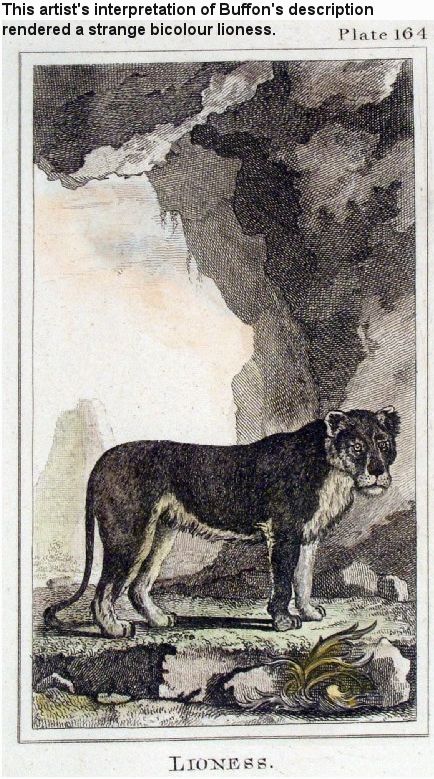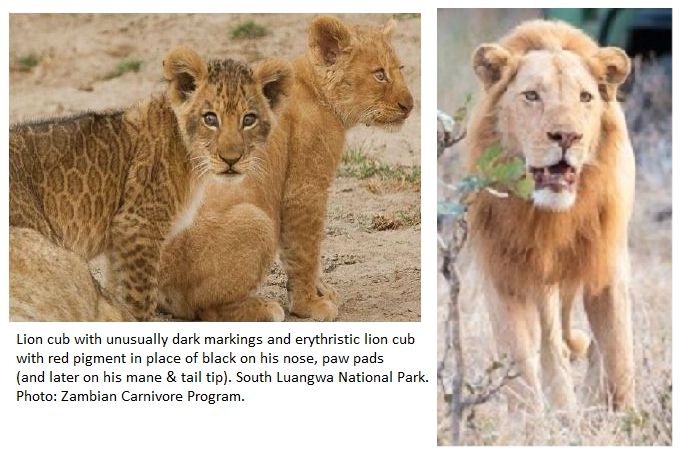
|
MUTANT BIG CATS - BLACK LIONS & RED LIONS |
Mutants are natural variations which occur due to spontaneous genetic changes or the expression of recessive (hidden) genes. Recessive genes show up when there is inbreeding. The colours and patterns that are anomalous in big cats are common in domestic cats so why are they less common in big cats? Wild cats displaying unusual traits may be less likely to survive to pass on the traits. In captivity, humans control which traits are bred, hence the multitude of domestic cat colours and types. In the wild, nature selects against any trait which does not enhance the animal's survival chances. In the past, the obvious reaction to any unusual big cat was to shoot it for the trophy room. As a result, many interesting mutations may have been wiped out before the genes were passed on. Some colour mutations which would disadvantage a wild big cat are bred in captivity and are not viable in the wild. It is questionable whether these mutants should be perpetuated for the sake of curiosity or aesthetics alone.
I am grateful to Paul McCarthy and Mary Ann Howell for researching and providing extensive material, information and corrections. Nowadays, “black lion” often refers to the black-maned Ethiopian or Barbary lions.

BLACK LIONS
“The Persian Language in Yuan-Dynasty China: A Reappraisal,” by Stephen G. Haw, is very helpful in unravelling the 12th and 13th century reports of “black lions” when the animal is clearly – to modern readers – a black leopard (panther). Odoric of Pordenone (a missionary explorer) wrote that “black lions in very great numbers” were found in India. Odoric’s usage of the word suggests that mediaeval Europeans used ‘lion’ as a general word for any big cat. The best way to describe an unfamiliar big cat, such as a black leopard, was to compare it to a more familiar animal – a lion. In the 18th and early 19th century, the term “tiger” was often used by Europeans as the generic word for big cat e.g. South American tigers (jaguars) and black tigers (black leopards).
There is a mid 19th century report of a very large "black" Persian lion seen by the archaeologist Sir Henry Layard; he described it as "very dark brown in colour, in parts almost black." Lions are no longer found in that region. This may have been related to the Barbary lion (now extinct in the wild) which is larger than African lions and famed for their extensive black manes stretching from chest to groin.
A partly black lion was born at Glasgow (Scotland) zoo, but was infertile. His colour was probably due to somatic mosaicism (abnormal skin cells). The lion had a pitch black patch extending the length of the inside front leg and across the chest. Somatic mosaicism causes some patches of skin to develop abnormal pigmentation. This anomaly also occurs in domestic cats and accounts for some of the few fertile tortoiseshell male cats.
In 1974, Glasgow Zoo purchased three young lions for £750 from Belle Vue Zoo, Manchester. They were descended from Chipperfield (circus) lions which were bred for their large, dark manes and which looked rather showier than imported African lions. The first litter of cubs produced by those lions comprised two male cubs, one of whom was born with a black patch that stretched from his right paw, all the way up the inside of his leg and across his chest. It was believed to be the first time melanism (in this case partial melanism) had been recorded in the African lion, and it appeared to be a somatic mutation. Named Ranger (he was sponsored by Glasgow Rangers Football Club), this lion frequently mated, but his consort never conceived. She was a proven breeding female, so the issue must have been with Ranger’s fertility, and staff suspected a chromosomal abnormality. Ranger was euthanized in 1997, aged 22 years, due to a serious old-age-related disorder. It was hoped that blood samples would allow testing for chromosome abnormality, but it was not possible to get testable blood samples. It would have been sensible to analyse tissue samples from the black area and golden area. A sample of testicular tissue should very definitely have been tested!
Unfortunately science was not so well developed at that time for DNA testing to be carried out, but Dr Irene McAndlish of the Glasgow Veterinary School believed that the melanistic patch was similar to that sometimes seen in domestic cats and which also results in sterility. This is a fallacy - it is not the melanistic patches that cause sterility in domestic cats, it is (sometimes) a chromosomeal abnormality that cause both black patches and sterility. At the time, tortie males were believed to be due to XXY chromosome makeup. This could not have been the case for Ranger because, unlike domestic cats, lions don’t have a “black” gene and probably don’t have a sex-related orange gene.
Black patches caused by localised mutation of skin cells should have no effect beyond the affected cells though possibly Ranger's mutation also affected internal tissues, included the testes. Localised mutations aren't hereditary unless the testes are also affected. If the testes were affected then Ranger might have sired black cubs instead of golden ones. If Ranger had been fertile and his trait had been hereditary then the zoo could have bred black lions (and possibly tortie female lions). After all, black leopards and black jaguars are always crowd pullers!
Black lions, chocolate brown lions and reddish brown lions have been reported. A very dark brown, almost black lion was reported in Persia (Iran) and a black lioness was reported in the African bush (Okovango). There have even been reports of whole prides of dark brown or black lions; prides comprise closely related lionesses therefore this could be a familial trait. Genetically, lions are spotted cats (residual spots can be seen on tawny lions on the limbs and sometimes on the body) and it's possible that excessively spotted cubs (abundism) might grow into adults with a sooty cast on the fur.
|
Not a black or chocolate lion, simply a lioness partially silhouetted. Many reports of black lions (and other black big cats) are due to observation in either poor light or with strong sunlight behind the cat. |
In May 2008, large black lions were alleged to be roaming the streets of Matsulu township outside the Mpumalanga capital in South Africa. Residents made anonymous phone calls to the Mpumalanga Tourism and Parks Agency (MTPA) about "black lions" that had supposedly escaped from the neighbouring Kruger National Park. While the MTPA took the phone calls seriously, no lions were found by officials sent to search the area and it is believed these were tawny lions seen in poor light or at night when they might appear black. According to a news report titled "Black lions terrify township": Big black lions are said to be roaming the streets of Matsulu township outside the Mpumalanga capital, terrifying residents who say they are too afraid to walk outside at night. Residents have been making anonymous phone calls to the Mpumalanga Tourism and Parks Agency (MTPA) about “black lions” that have escaped from the neighbouring Kruger National Park, said MTPA spokesperson Jimmy Masombuka on Thursday. “We have been receiving these calls from frightened residents who tell us that they spotted black lions prowling the area .... It is surprising for us to hear of black lions. But, although it’s hard to believe, you don’t just dismiss these kind of things. Maybe we are sitting on a great discovery,” he said. Masombuka said some people who said they had seen may have mistaken the dark brown colours for black, or perhaps they had seen the lions at night.".
An image of a white lion posted at cutehomepets.com was transformed into a black lion by "PAulie-SVK" and posted at deviantart.com in 2012. The "black lion" photo has since spread around the internet accompanied by claims that it is a genuine melanistic lion.
The multitude of "Black Lion" pubs in Britain is sometimes cited as evidence for historical occurrences of black lions. However there are also plenty of "blue lion" and "red lion" pubs - the lions depicted originally being heraldic devices (generally a lion rampant).
RED LIONS
Ginger, from South Luangwa, in Zambia is an erythristic lion. He was one of 3 unusually marked cubs born in 2008. One had such dark markings it resembled a leopard cub. Ginger was born with a very light coloured coat and he hacks the dark pigmentation usually found on the nose and paw pads. His mane and tail tip were orange; the tail tip is usually black.

Textual content is licensed under the GFDL.
For more information on the genetics of colour and pattern:
Robinson's Genetics for Cat Breeders & Veterinarians 4th Ed (the current version)
Genetics for Cat Breeders, 3rd Ed by Roy Robinson (earlier version showing some of the historical misunderstandings)
Cat Genetics by A C Jude (1950s cat genetics text; demonstrates the early confusion that chinchilla was a form of albinism)
For more information on genetics, inheritance and gene pools see:
The Pros and Cons of Inbreeding
The Pros and Cons of Cloning
For more information on anomalous colour and pattern forms in big cats see
Karl Shuker's "Mystery Cats of the World" (Robert Hale: London, 1989 - some of the genetics content is outdated)
|
BACK TO HYBRID & MUTANT BIG CATS INDEX |